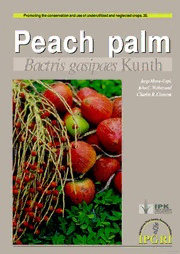
Peach Palm, Bactris Gasipaes Kunth PDF
Preview Peach Palm, Bactris Gasipaes Kunth
Promotingtheconservationanduseofunderutilizedandneglectedcrops.20. Kunth Bactris gasipaes ora-Urpiy JohnC.Weberand CharlesR.Clement . Peachpalm.BactrisgasipaesKunth The International Plant Genetic Resources Institute (IPGRI) is an autonomous internationalscientificorganizationoperatingundertheaegisoftheConsultative GrouponlnternationalAgriculturalResearch(CGIAR).TheinternationalstatusofIPGRI isconferredunderanEstablishmentAgreementwhich,byMarch1997,hadbeensigned bytheGovernmentsofAlgeria,Australia,Belgium,Benin,Bolivia,Brazil,BurkinaFaso, Cameroon,Chile,China,Congo,CostaRica,Coted'lvoire,Cyprus,CzechRepublic, Denmark,Ecuador,Egypt,Greece,Guinea,Hungary,India,Indonesia,Iran,Israel,Italy, Jordan,Kenya,Malaysia,Mauritania,Morocco,Pakistan,Panama,Peru,Poland,Portugal, Romania,Russia,Senegal,SlovakRepublic,Sudan,Switzerland,Syria,Tunisia,Turkey, UgandaandUkraine.IPGRI'smandateistoadvancetheconservationanduseofplant geneticresourcesforthebenefitofpresentandfuturegenerations. IPGRIworksin partnershipwithotherorganizations,undertakingresearch,trainingandtheprovisionof scientificandtechnicaladviceandinformation,andhasaparticularlystrongprogramme linkwiththeFoodandAgricultureOrganizationoftheUnitedNations.Financialsupport fortheresearchagendaoflPGRIisprovidedbytheGovernmentsofAustralia,Austria, Belgium,Canada.China.Denmark,Finland,France,Germany,India,Italy,Japan,the RepublicofKorea,Luxembourg,Mexico,theNetherlands,Norway,thePhilippines,Spain, Sweden,Switzerland,theUKandtheUSA,andbytheAsianDevelopmentBank,CTA, EuropeanUnion,IDRC,IFAD,InteramericanDevelopmentBank,UNDPandtheWorld Bank. TheInstituteofPlantGeneticsandCropPlantResearch(IPK)isoperatedasanindependent foundationunderpubliclaw.ThefoundationstatuteassignstoIPKthetaskofconductingbasic researchintheareaofpIantgeneticsandresearchoncuItivatedplants Thegeographicaldesignationsemployedandthepresentationofmaterialinthis publicationdonotimplytheexpressionofanyopinionwhatsoeveronthepartofIPGRI, theCGIARorIPKconcerningthelegalstatusofanycountry,territory,cityorareaorits authorities,orconcerningthedelimitationofitsfrontiersorboundaries.Similarly,theviews expressedarethoseoftheauthorsanddonotnecessarilyreflecttheviewsofthese participatingorganizations. Citation: Mora-Urpi,Jorge,JohnC.WeberandCharlesR.Clement.1997.Peachpalm.Bactris gasipaesKunth.Promotingtheconservationanduseofunderutilizedandneglectedcrops. 20.InstituteofPlantGeneticsandCropPlantResearch,Gatersleben/ InternationalPlant GeneticResourcesInstitute,Rome,Italy. ISBN 92-9043-347-7 IPGRI IPK ViadelleSetteChiese 142 Corrensstrasse 3 00145Rome 06466 Gatersleben Italy Germany © InternationalPlant Genetic Resources Institute, 1997 Promotingtheconservationanduseofunderutilizedandneglectedcrops.20. 3 Contents Foreword 5 Acknowledgements 6 1 Tntmdnotion 7 2 Taxonomy,nomenclature and geographical distribution 8 2.1 Taxonomy 8 2.2 Botanicaland vernacularnames 10 2.3 Geographicaldistribution 10 3 Description ofthe cultivated species 12 3.1 Morphologicaldescription 12 3.2 Ecology 14 3.3 Developmentofthestem and inflorescence 16 3.4 Reproductivebiology 17 4 Usesand properi;ies 20 4.1 Traditionalfood products 20 4.2 Currentfood products and theirproperties 20 4.3 Minorproducts 24 5 Origin and domestication 26 6 Geneticresources 28 6.1 Diversity among and within landraces 28 6.2 Existinggermplasm banks 30 6.3 Usefulandunusualphenotypes 32 6.4 Geneticerosion 33 6.5 Germplasm collecting and conservation 33 7 Geneticimprovementstrategies 36 8 Propagation 39 8.1 Pollen collecting,handling and controlledpollination 39 8.2 Seed 40 8.3 Asexualpropagation 42 9 Agronomyoffruitand heart-of-palmproduction 44 9.1 Fruit:planting density and pruning 44 9.2 Fruit:mineral nutrition 44 9.3 Fruit:harvestand post-harvesthandling 45 9.4 Heart-of-palm:planting density and pruning 46 9.5 Heart-of-palm: mineralnutrition 49 9.6 Heart-of-palm: harvestand post-harvesthandling 52 9.7 Pests and pathogens 54 10 Production areas and commercialpotential 58 10.1 Fruit 58 10.2 Heart-of-palm 59 11 Limitationsandprospects ofthecrops 61 12 Futureresearchneeds 63 Copyf>ghiedmaierial Peachpalm.BactrisgasipaesKunth References 66 AppendixI.Institutions and scientists managing germplasm banksandconductingresearchonpeachpalm 78 Copyrightedmaterial Promotingtheconservationanduseofunderutilizedandneglectedcrops.20. 5 Foreword Humanityreliesonadiverserangeofcultivatedspecies;atleast6000suchspeciesare usedforavarietyofpurposes. Itisoftenstatedthatonlyafewstaplecropsproduce themajorityofthefoodsupply. Thismightbecorrectbuttheimportantcontribution ofmany minor species should notbe underestimated. Agricultural research has traditionallyfocusedonthesestaples,whilerelativelylittleattentionhasbeengiven tominor(orunderutilizedorneglected)crops,particularlybyscientistsindeveloped countries. Suchcropshave,therefore,generallyfailed toattractsignificantresearch funding. Unlikemoststaples,manyoftheseneglectedspeciesareadaptedtovarious marginalgrowingconditionssuchasthoseoftheAndeanandHimalayanhighlands, aridareas,salt-affectedsoils,etc. Furthermore,manycropsconsideredneglected at agloballevelarestaplesatanationalorregionallevel(e.g.tef,fonio,Andeanroots and tubers, etc.), contribute considerably to food supply in certain periods (e.g. indigenousfruittrees)or are importantfor anutritionally well-balanced diet(e.g. indigenousvegetables). Thelimitedinformationavailableonmanyimportantand frequently basic aspects of neglected and underutilized crops hinders their developmentand theirsustainableconservation. Onemajorfactorhamperingthis developmentis thattheinformation available on germplasm is scattered and not readily accessible, i.e. only found in 'grey literature' or written in little-known languages. Moreover,existingknowledgeonthegeneticpotentialofneglectedcrops islimited. Thishasresulted,frequently,inuncoordinatedresearcheffortsformost neglected crops, as well as in inefficient approaches to the conservation ofthese geneticresources. This series ofmonographs intends to draw attention to anumber ofspecies which have been neglected in a varying degree by researchers or have been underutilized economically. It is hoped that the information compiled will contributeto:(1)identifyingconstraintsinandpossiblesolutionstotheuseofthe crops, (2)identifying possible untapped geneticdiversity forbreeding and crop improvementprogrammesand(3)detectingexistinggapsinavailableconservation and use approaches. This series intends to contribute to improvement of the potential value of these crops through increased use of the available genetic diversity. In addition,itishoped thatthe monographs in the series willform a valuablereferencesourceforallthosescientistsinvolvedinconservation,research, improvementand promotion ofthesecrops. ThisseriesistheresultofajointprojectbetweentheInternationalPlantGenetic Resources Institute (IPGRI) and the Institute ofPlant Genetics and Crop Plant Research (IPK). Financialsupportprovided bytheFederalMinistryofEconomic CooperationandDevelopment(BMZ)ofGermanythroughtheGermanAgencyfor TechnicalCooperation (GTZ) is duly acknowledged. Serieseditors: DrJoachim Heller,InstituteofPlantGeneticsand Crop PlantResearch (IPK) DrJan Engels,InternationalPlantGeneticResources Institute (IPGRI) Prof.DrKarlHammer,InstituteofPlantGeneticsand Crop PlantResearch (IPK) CopyrigNedmalarial Peachpalm.BactrisgasipaesKunth Acknowledgements The authors are indebted to Dr Joachim Heller from IPGRI for his interest, assistanceand critiquewhilethismonographwasbeing written;toMsBonnieE. Avery (Oregon State University, Corvallis, Oregon, USA) for bibliographic services,andwithspecialrecognitiontotheNativeAmerindiansfordevelopingthe peach palm, and to the farmers and technicians whose work rests on this foundation, and hascontributed to the monograph. TheInternationalPlantGeneticResourcesInstitutewouldliketothankDrJan Engels and DrAndrew Henderson fortheircriticalreview ofthe manuscript. Copyrightedmaterial Promotingtheconservationanduseofunderutilizedandneglectedcrops.20. 7 1 Introduction Peachpalm{BactrisgasipaesKunth)wasastaplefoodcropformanypre-Columbian Amerindian communities in the lowland humid neotropics (Patino 1963). The Amerindiansdomesticatedpeachpalm anddistributed itthroughoutmuchofthe Amazon Basin,northwestern Andean region and CentralAmerica,producing in theprocessageneticallyrichlandracecomplex(Mora-Urpi 1993;Clement 1995a). Theyvaluedpeachpalmforseveralreasons:itwaseasytocultivateintraditional agroforestrysystems,ityielded welloninfertilesoils,thefruitscouldbeprepared intoavarietyofnutritiousfoods,andotherplantpartscouldbeconsumedorused for construction and other household needs. Most European colonists, however, overlooked thevalueofpeachpalm,preferringtocultivatecornandotherknown staplefoodcrops.Manypeoplestillcultivatepeachpalmonasmallscale,butitsreal potentialin thehumid neotropicshasbeen largelyneglected untilrecently. Peachpalmisbeingrediscoverednow,withpromisingnutritionalandcommer- cial benefits for resource-poor families in Latin America. Interest was rekindled primarilybyPatino'shistoricalreview(1958),CamachoandSoria'spaperonpeach palm's heart-of-palm (1970) and a National Academy of Science booklet on underexploitedtropicalplants (NRC 1975).Sincethen,nationaland international effortshavefocusedongermplasmexplorations,conservationandmanagementof geneticresources,geneticimprovement,agronomicmanagementand industrial- ization. Peach palm yields two food crops with commercialpotential: the fruit and heart-of-palm.Thefruitprovides severalnutritious,staplefoods:pulp fordirect consumption,flourforinfantformulaandbakedgoods,cookingoil,andrationfor farm animalsandfishculture(Blanco-Metzleretal. 1992a).Theflourisalreadyon themarketinpartsofCentralandSouthAmerica,andthereareplansforcommer- cialproduction ofanimalration.Theprocessingofgourmetheart-of-palmforthe internationalmarketisgrowingintoamajoragro-industryinproducingcountries (Villachica1996). Thegenepoolofcultivatedpeachpalmanditswildrelativesisrichindiversity. There isconsiderablevariation in commercially importanttraitsthatcould serve future genetic improvement programmes for fruit products and heart-of-palm (Clementand Mora-Urpi 1987;Mora-Urpfetal. 1993).Unfortunately,geneticero- sionisoccurring withinlandracesand wild relatives,creating an urgentneed for new explorationstocollectgermplasmofhighutilityvalue,andfordevelopment ofsustainable strategies toconservegermplasm through use. Theobjectiveofthismonographistomakeinformationmorereadilyavailable tothose interested in thefood-crop potentialand geneticresourcesofcultivated peachpalm. Itishoped thatthiswillstimulatefurtherinterestinthecommercial developmentofpeachpalm inthelowland humid neotropics. : . Peachpalm.BactrisgasipaesKunth 2 Taxonomy, nomenclatureand geographical distribution 2.1 Taxonomy ThecultivatedpeachpalmiscorrectlyreferredtoasBactrisgasipaesKunth(Uhland Dransfield1987),butotherepithetsarestillfoundintheliterature.Peachpalmhasbeenplaced intwodifferentgeneraatvarioustimesBactrisJacquin(1777)andGmilielmaMartius(1826) Drude(1887)wasthefirsttoplaceGuilielmaasasubgenuswithinBactris.Burret(1934), however,acceptedGuilielmaasagenusandreducedseveralspeciestosynonymywithB. gasipaes,followingBailey(1930).MacBride(1960)agreedwithDrude'sdecisionbasedon externalmorphology,butTomlinson(1961)supportedBurret'sdecisionbasedupon differencesinfiberanatomyintheleaves.UhlandDransfield(1987),thecurrentstandard, placefl.gasipaeswithinBactriswithoutdefiningasubgenericcategory.Sanders(1991),on thebasisofapreliminarycladisticanalysis,considersfiacrratobeamonophyleticgenusif Gw/fe/maisrecognizedasasectionwithinanexpandedsubgenusthatalsoincludesan Antilleansection. JustastheexistenceofGuilielmaitselfhasbeenquestioned,thenumberofspecies includedwithinithaswaxedandwanedduringthelast175years.Mora-UrpfandClement (1981)andClement(1988)reviewedthishistoryandidentifiedacoregroupoftaxathathave remainedwithin Guilielmaup tothepresent,although Henderson (1995)recently questionedthevalidityofmanyofthem.Mora-Urpf(1992)andMora-Urpietal.(1993) listedseveraltaxathatmaybenewspecieswithinGM///e/ma,buttheyhavenotyetbeen describedintheliterature.BecauseGw/Z/e/maiscurrentlyinquestion,Clement(1995a) proposedtheadoptionofHarlananddeWet's(197l)genepoolterminologytoorganize thesetaxaintoprimaryandsecondarygenepools.Theprimarygenepool(5.gasipaes)has adomesticatedsubspecies(utilis)thatcontainsthelandraces,andawildsubspecies (^pm'o^a)thatcontainsapparentlywildpopulationsof5.goy/pae^,someofwhichwere originallydescribedasspecies.ThesecondarygenepoolcontainsotherGuilielmaspecies thatprobablycanhybridizewithB.gasipaes.Thetertiarygenepoolcontainstheremaining speciesofBactris. Table1outlinesthisproposalandsomeofthecontroversysurroundingmanyofthe taxa.Mora-Urpfs(1993)proposalthattheGuilielmacomplexisacoenospeciesis conceptuallyverysimilartothegenepoolproposal,buttheformerterminologyismore widelyused.AttheNewYorkBotanicalGarden,A.Hendersoniscurrentlyconductinga systematicrevisionofBac^n.s'thatmayresolvethecontroversy,especiallywhenresultsof isozymeandDNAstudiesareincluded.Henderson's(1995)firstproposal,however, reducestheentireprimarygenepooltofi.ga^/pae^andtheentiresecondarygenepoolto5. macana,withoutcommentoranalysisofvariation.Becauseoftheuncertaintyaboutthe originofcultivatedpeachpalmandthepotentialimportanceofwildpopulationsand relatedspeciesingeneticimprovementprogrammes,thetaxonomicrevisionshouldbe basedonathoroughanalysisofvariationwithintheGM///e/wacomplexandthepartition of this variation among and within the species that are finally accepted. Copyftghiedmaierral 6 Promotingtheconservationanduseofunderutilizedandneglectedcrops.20. Table1. CloselyrelatedspeciesoftheGi////e//7iacomplex,representedbytheir originalnames Species Location Observations BactrisgasipaesKunth181 Ibague, Colombia Allthreenames GuilielmaspeciosaMartius18241 Maranhao, Brazil correspondtocultivated GuilielmautilisOersted 18582 Turrialba, Costa Rica peachpalm GuilielmachontaduroTriana18543 CaucaValley,Colombia Wildrelativesofpeach Bactrisspeciosayar.chichaguiKarsien18574MagdalenaValley, Colombia palm.Theyneeda GuilielmainsignisMartius 18445 Beni, Bolivia taxonomic revision to MartineziaciliataRuiz&Pavon 17986 Huanuco,Peru reconfirmthem as GuilielmamicrocarpaHuber19048 Ucayali, Peru different speciesor GuilielmamacanaMartius18449 Maracaibo, Venezuela synonyms BactriscaribaeaKarsten 185710 Perija, Venezuela Chontilla(undescribed)7 Esmeraldas, Ecuador Newlyfoundwild Darien (undescribed)l1 Darien,Panama relativesofpeach Ca-Pu (undescribed)12 Alto Putumayo-Caqueta palm Rivers,Colombia Azuero (undescribed)13 Azuero, Panama 1 Bailey(1930)reducedG.speciosatosynonymywithB.gasipaes(asG.gasipaes,becausehe accepted Guilielma). Drude (1881) namedaspineless mutantvar. mitis. Barbosa-Rodriguez (1903) namedthreevarieties {flava, coccineaand ochracea)thatare normalvariantsin most cultivatedpopulations. Noneofthesevarietiesisacceptedtoday. 2 Bailey(1930)suggestedthatG.utilismaybeasynonymofB.gasipaesbutdidnotreduceitto synonymy.Burret(1934)acceptedG.utilis.Glassman(1972)reducedittosynonymywithS.gasipaes. 3 Burret(1934)didnotmentionG.chontaduro. Glassman(1972)reducedittosynonymywithB. gasipaes. Dugand(1976)reducedittoavarietyofB.gasipaes.Thistaxoniscalled'chinamato' intheupperCaucaRivervalley,Colombia. 4 Alsodenominatedvar.chiquictiiquiKarsXen.GiventhegeographicproximitybetweenGuilielma chontaduroandB.speciosavar.chichagui,theymaybesynonymous. 5BalslevandMoraes(1989)mentionthatBurret(1934)thoughtthatG.insignisshouldbereduced tosynonymywithB.gasipaesbutBurretdidnotdoso. Saldias-Paz(1991)providedextensive numericaldataonG.insignispopulationsnearSantaCruzdelaSierra,Bolivia. Henderson(1995) reducedittosynonymywithB.gfas/paeswithoutcommentorananalysisofmorphologicalvariation. 6 Martius(1826)transferredM.ciliataioBactris,andWendland(1878)transferredittoGuilielma. Burret(1934),MacBride(1960)andGlassman(1972)acceptedit. Bernal(1989)reduceditto synonymywithB.gasipaeswithoutananalysisofmorphologicalvariationornewcollectionsin thetypelocations.ThephotographofM.ciliatainDahlgren(1936)suggeststhatitissimilartoG. microcarpa,andmuchsmallerthanG.insignis,butHenderson(1995)acceptsBernal'sconclusion withoutcomment.IfM.ciliataissimilartoG.insignis,thiscontradictsHenderson'sdescriptionof B.gasipaes. CopyrigNedmalarial 1-10 Peachpalm.BactrisgasipaesKunth Mora-UrpfcollectedChontillain1988,andplanteditintheUniversityofCostaRicagermplasmcollection. ItlookslikeasmallG.insignisbutisfound2000kmfromBoliviaandontheothersideoftheAndes.Ithas notbeendescribedbya6ac?r/sspecialist. 8 MacBride(1960)thoughtthisanomennodum,butGlassman(1972)acceptedit,renamingitB. dahlgreniana.Clementetal.(1989)providedextensivenumericaldataonB.daWgfren/anapopulationsin RondoniaandAcre,Brazil,andrecentlyfoundanewpopulationfurtherwestinAmazonas. 9Thisistheonlysmall-fruitedspeciesacceptedbyHenderson(1995),sinceheplacesallothersmall-fruited Guilielmas'msynonymywithit,buthisargumentthatthisistheancestralformofB.gfas/paesessentially reducesittosynonymywith6.gasipaes. Dugand(1976)suggestedthatS.car/foaeawassynonymouswithG.macana,butneverpublishedaformal proposal. ''''Mora-UrpicollectedDarienin1986,andplanteditintheUniversityofCosta Ricagermplasmcollection.ItlookssomewhatlikeaB.dahlgrenianaorB.macana,buthasnotbeen describedbyaSac^r/sspecialist. 12AUS-AIDfinancedprospectionteamcollectedCa-Puin1984(ClementandCoradin1988).Itlookslike aGuilielma,butisquiteunlikeB.gasipaes.Unfortunately,noneoftheseedgerminated,soitisnot representedinanygermplasmcollection. "13Collectedin1996inCerroHoyaNationalPark,PanamabyJ.Mora-UrpfandplantedintheUniversity ofCostaRicagermplasmcollection.Ithasnotbeendescribed. Thedistributionofpeachpalmtodayinvolvesacomplexpatternoflandraces(Mora-Urpf 1984;Clementl988;Mora-UrpfandClement1988;Mora-Urpf1992).Ithasbeendividedinto OccidentalandOrientalsubcomplexesbasedonvegetativedifferences(Mora-Urpfl984),and fiirtherdividedintoclassesbasedonfruitsize(Mora-UrpiandClement1988;Mora-Urpfl992; Mora-Urpietal.1993):the'microcarpa'landraceshavesmallfruits(<20g),the'mesocarpa' landraceshavefruitsofintermediatesize(20-70g),andthe'macrocarpa'landraceshavevery largefruits(70-250g). 2.2 Botanical and vernacular names BactrisgasipaesKunth,familyPalmae(Arecaceae).Commonsynonyms:GM///e/wa speciosa Martins, Guilielma gasipaes (Kunth) Bailey, Guilielma utilis Oersted. Haploidchromosomenumbern=14(Mora-UrpfandSolfs1980),butRead(1966) reportedn=\5. Therearemorethan200vernacularnamesfor5(3c?mg<35'/p«3e5Kunth(Patiiio1960). Themostcommonare:peachpalmandpewapalm(Trinidad),/7e/7Z?(3tje(CostaRicaand Nicaragua),p/i'a(Panama),p(/7gMaoandmacana(Venezuela),c/?on?aJMro(Colombiaand Ecuador),p(/May(9(Peru),fewi>eandpalmadeCastilla(Bo\i'via.),pupunha(Brazi\),parepon (FrenchGuayana).Thebotanicalepithet(gas/p(2ej')isderivedfromthevernacularname usedintheMagdalenaRivervalleyofColombia(cac/?/pay). 2.3 Geographical distribution Cultivatedpeachpalmhadawidegeographicaldistributioninpre-Columbiantimes, extendingfromcentralBoliviatonortheasternHonduras(approx.17°Sto16°N)andfrom themouthoftheAmazonRiverandGuayanastothePacificcoastofEcuadorandColombia intoCentralAmerica(Fig.l);todayitextendsnorthtoMexicoandtosomeCaribbeanIslands, andhasbeentakentoothercontinents.ThewildspeciesofGM///e/wfl(Fig.2)extendfrom Bolivia-RondonianorthtotheupperCaquetaRiverareainthewesternAmazonBasin,and westoftheAndesMountainsfromthecentralcoastofEcuadortoNicaragua(Conzemius 1932;ArroyoandMora-Urpf1996). Cop/fghledmalerial
